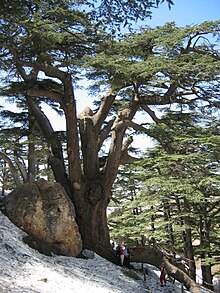Cedrus libani
| Cedrus libani A. Rich. | ||||||||||
 © Wikimedia Commons | ||||||||||
| Taxonomic classification | ||||||||||
| ||||||||||
| Conservation status | ||||||||||
|
| ||||||||||
| Endemism | ||||||||||
| Common names | ||||||||||
|
| Cedrus libani A. Rich. | ||||||||||
 © Wikimedia Commons | ||||||||||
| Taxonomic classification | ||||||||||
| ||||||||||
| Conservation status | ||||||||||
|
| ||||||||||
| Endemism | ||||||||||
| Common names | ||||||||||
|
Cedrus libani is an evergreen conifer growing on calcareous, well-drained soils on high mountains, at altitudes of 1200-1900m above sea level. It is adapted to cold winters, snow, frost, as well as drought.
This tree can reach a height of 40m. It has dark gray to blackish brown scaly bark that features horizontal fissures. Leaves are quadrangular and needle-like (15-35mm x 1mm), arranged in spirals on long shoots, and in rosettes on short shoots. Younger trees tend to have a greenish color and a pyramid-shaped canopy, while old trees are grayish and form a broad canopy with distinct horizontal branches.
Male cones are erect catkins, 4-5cm, pale green to orange-brown. Female cones are barrel-shaped, 7-10cm x 4-7cm, sessile, resinous, pale green to purplish-gray, which turn brown at full maturity. Both male and female cones grow on the same tree (monoecious plant), on the terminal end of short shoots. The seeds are ovoid, thin and winged.
Synonyms
This species may also be referred to as:
Abies cedrus, Cedrus brevifolia, Pinus cedrus
Possible confusion
This species might be confused with the following similar-looking species:
{{{confusion_list}}}
Abies cilicica (which is only found in North Lebanon)
- ↑ Gardner, M. 2013. Cedrus libani. The IUCN Red List of Threatened Species 2013: e.T46191675A46192926. https://dx.doi.org/10.2305/IUCN.UK.2013-1.RLTS.T46191675A46192926.en



